Chapter 11
A Gag Down Under
The 1st Marine Division’s George Medal
By Owen Linlithgow Conner, Chief Curator
Featured artifacts: George Medal with Citation and Pin (1974.8.1); and Australian-made 1st Marine Division Patch (1984.643.1)
When times are at their worst, U.S. Marines have often found a way to alleviate their problems through dark humor. This unique sense of humor regularly benefits from the misery of watching others’ discomfort. It is a long-standing comic tradition. In the 1930s, the famous vaudeville performer Will Rodgers once quipped, “Everything is funny, as long as it’s happening to somebody else.” In the case of the Marines, however, dark comedy often came at their own expense.
In poking fun at their shared suffering, Marines have a long and storied tradition of creating unofficial gag medals, which typically take the form of grandiose comic citations in recognition of the absurdity of any given situation. The most famous example of such an award is the famous Soochow Creek medal from China in the 1930s. These medals were created and “issued” to Marines who were forced to serve as spectators—who happened to be ducking live munitions and facing the threat of gas attacks—during two separate phases of the Chinese Japanese wars in 1932 and 1937.[1]
Inspired by their suffering during the World War II campaign on Guadalcanal in 1942, a small group of Marines with the 1st Marine Division decided to design their own novelty medal. Exposed to more than four months of savage combat on Guadalcanal, the battered division arrived in Australia in 1943 determined to heal and rebuild. During this period, talented officers from the division intelligence section set out to create an “award” in recognition of their continual misfortune. Ever since their formative days at New River, North Carolina, these Marines felt that their division was always assigned the hardest work. Following a popular idiom of the time—“Let George do it!”—the expression became the division’s unofficial motto. As a result, their medal was christened the “George Medal.”
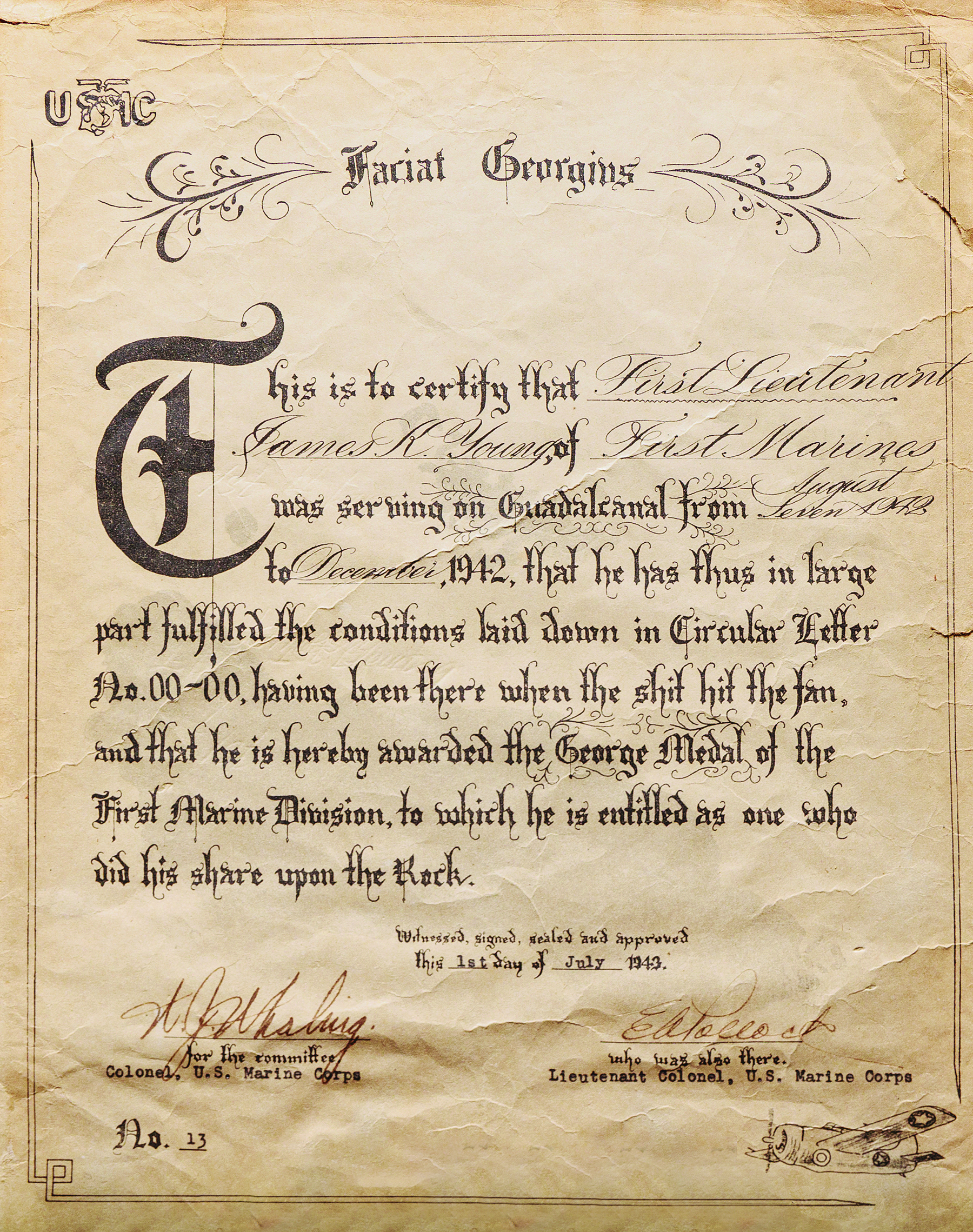
Original George Medals were accompanied by a humorous certificate created by the 1st Marine Division’s lithographic section.
Photo by Jose Esquilin, Marine Corps University Press.
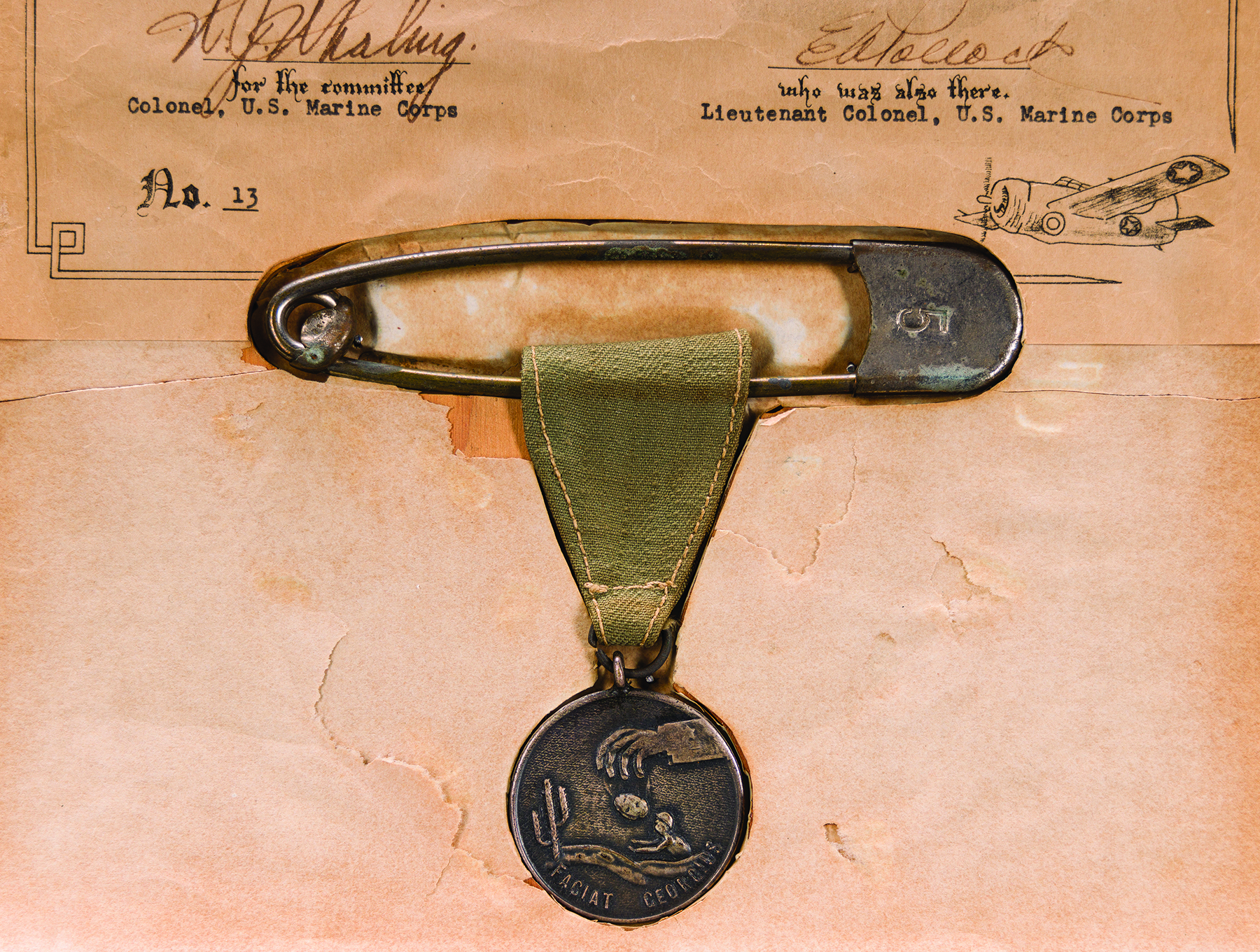
The 1st Marine Division received their proverbial “hot potato” during the Battle of Guadalcanal.
Photo by Jose Esquilin, Marine Corps University Press.
To properly understand the dark humor of the George Medal, it is important to understand the history of the events surrounding it. The Guadalcanal campaign was possibly the most crucial action of the Pacific theater in World War II. It occurred in the early days of the war when American victory was not assured, and the Japanese Empire still held the upper hand. U.S. naval victories at the Battles of the Coral Sea and Midway had begun to blunt Japan’s imperial ambitions, but an enemy victory on Guadalcanal could reenergize their efforts and spell disaster for the Allied forces in the Pacific.[2]
The initial landing of elements of the 1st Marine Division on Guadalcanal, Tulagi, and Florida Islands in the South Pacific’s Solomon Islands chain on 7 August 1942 marked the United States’ first significant ground offensive against the Japanese. Their goal was to prevent the Japanese from using Tulagi and Guadalcanal as staging bases and airfields. It was not going to be an easy fight. The Marine landing forces had been hurriedly assembled, while the U.S. Navy, still licking its wounds from severe losses of ships and sailors in its recent naval victories, were desperately short of available warships and valuable transports.[3]
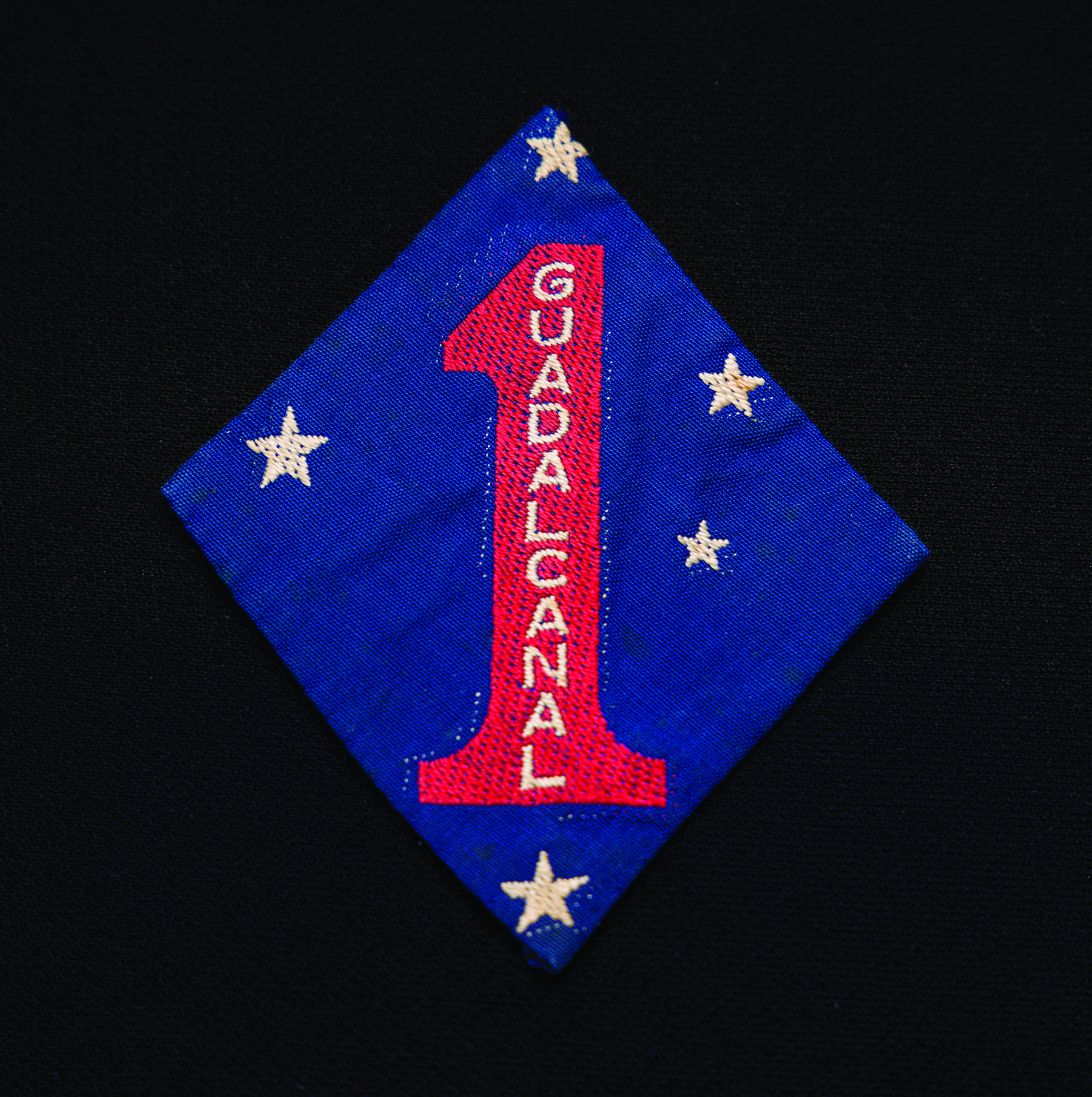
An Australian-manufactured 1st Marine Division patch worn by LtCol Merrill B. Twining.
Photo by Jose Esquilin, Marine Corps University Press.
The future days of U.S. naval dominance and limitless resources were a distant hope in 1942. While American innovations such as radar would provide a future edge, these systems were untested and still in their infancy from an operational perspective at this time. As a result, the fierce fighting that would occur in the Guadalcanal area from 7 August 1942 to 9 February 1943 became a titanic see-saw of brutal combat, with U.S. and Allied naval and air forces ruling the daytime and the Japanese ruling supreme at night. During the naval Battle of Savo Island on 8–9 August 1942, the Imperial Japanese Navy displayed its excellence in night fighting. The enemy’s superior optics gave them the edge and a shocking victory over U.S. Navy rear admiral Richmond K. Turner’s amphibious fleet, which was operating in Savo Sound, the strait that stretched between Guadalcanal and Florida Island. Three American and one Australian heavy cruiser were sunk, while an additional cruiser and destroyer were heavily damaged. More than 1,000 Allied sailors were killed. Following their defeat at Savo Sound—renamed “Ironbottom Sound” by the Marine spectators—the naval commanders on the scene reconsidered their roles and risks in the battle. They chose to withdraw their transports and reposition their vital aircraft carriers to fight another day. This initially left the 1st Marine Division with a mere 17 days of rations and just 4 days of ammunition for the ensuing battle.[4] The Marines felt abandoned and cut off.

Marine officer Donald L. Dickson took part in the fighting on Guadalcanal, often taking time to sketch images of the conditions that the Marines endured there.
National Museum of the Marine Corps.
After nearly six months of back-and-forth fighting, U.S. forces on the islands would ultimately prevail over the Japanese, but victory came at a heavy cost. Between the Marines and U.S. Army soldiers, approximately 1,598 officers and enlisted were killed, and more than 4,700 were wounded. The heroic Marine, Army, and Allied aviators flying from Henderson Field on Guadalcanal suffered nearly 300 casualties. The Japanese lost close to 25,000 troops in ground operations.[5] Despite the U.S. Navy’s true valor in the campaign, the Marines held long memories and would not forget “the touch and go” peril they were exposed to during the campaign. The shock of watching their transports sail away and the horrors of enduring nighttime Japanese naval bombardments created lasting memories. When they were finally relieved, these sentiments were carried back with them to Australia as they took time to rest, recover, and refit.
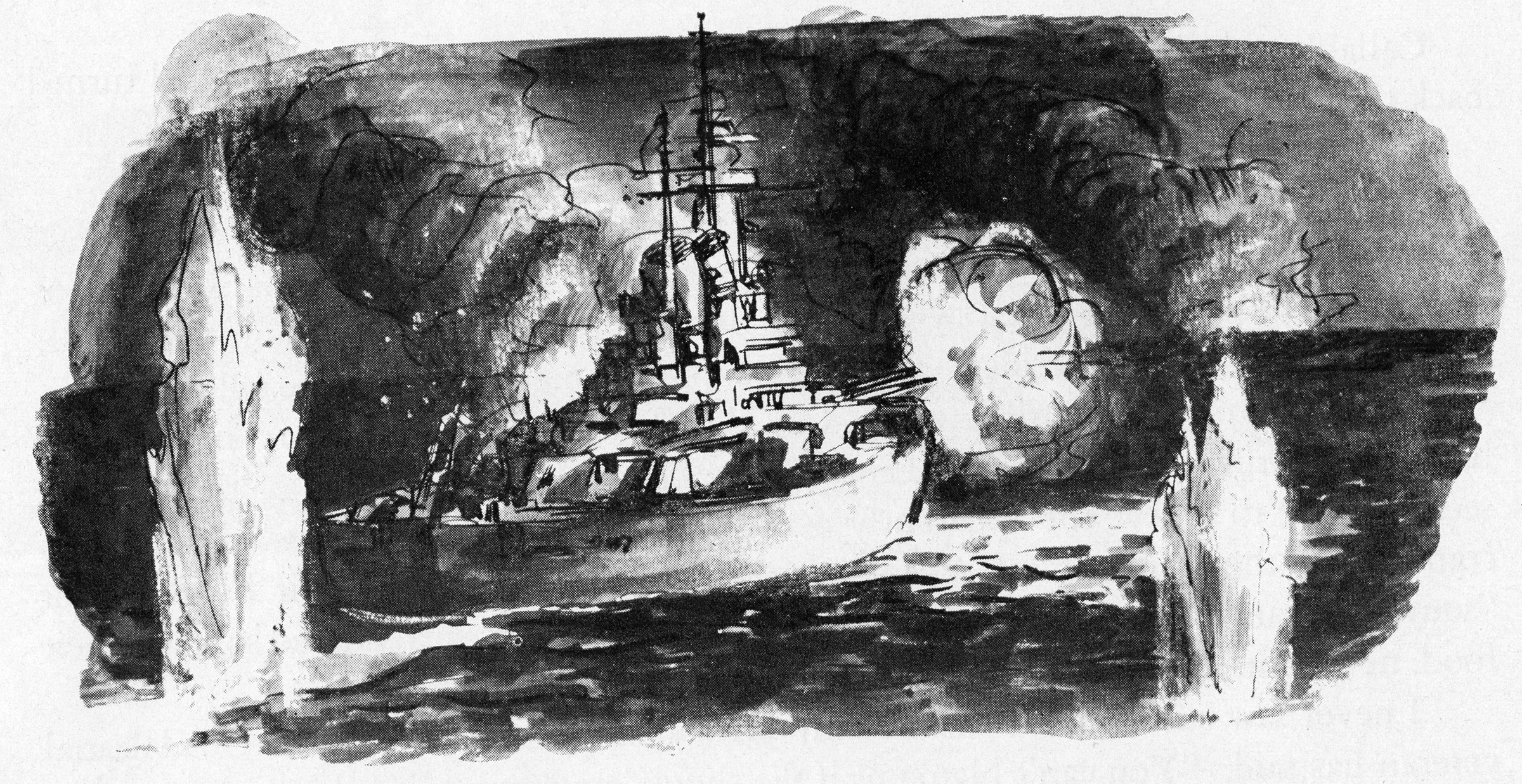
This image comes from the 1st Marine Division’s postwar book, The Old Breed: A History of the First Marine Division in World War II, by George McMillan (1949).
Official U.S. Marine Corps photo.
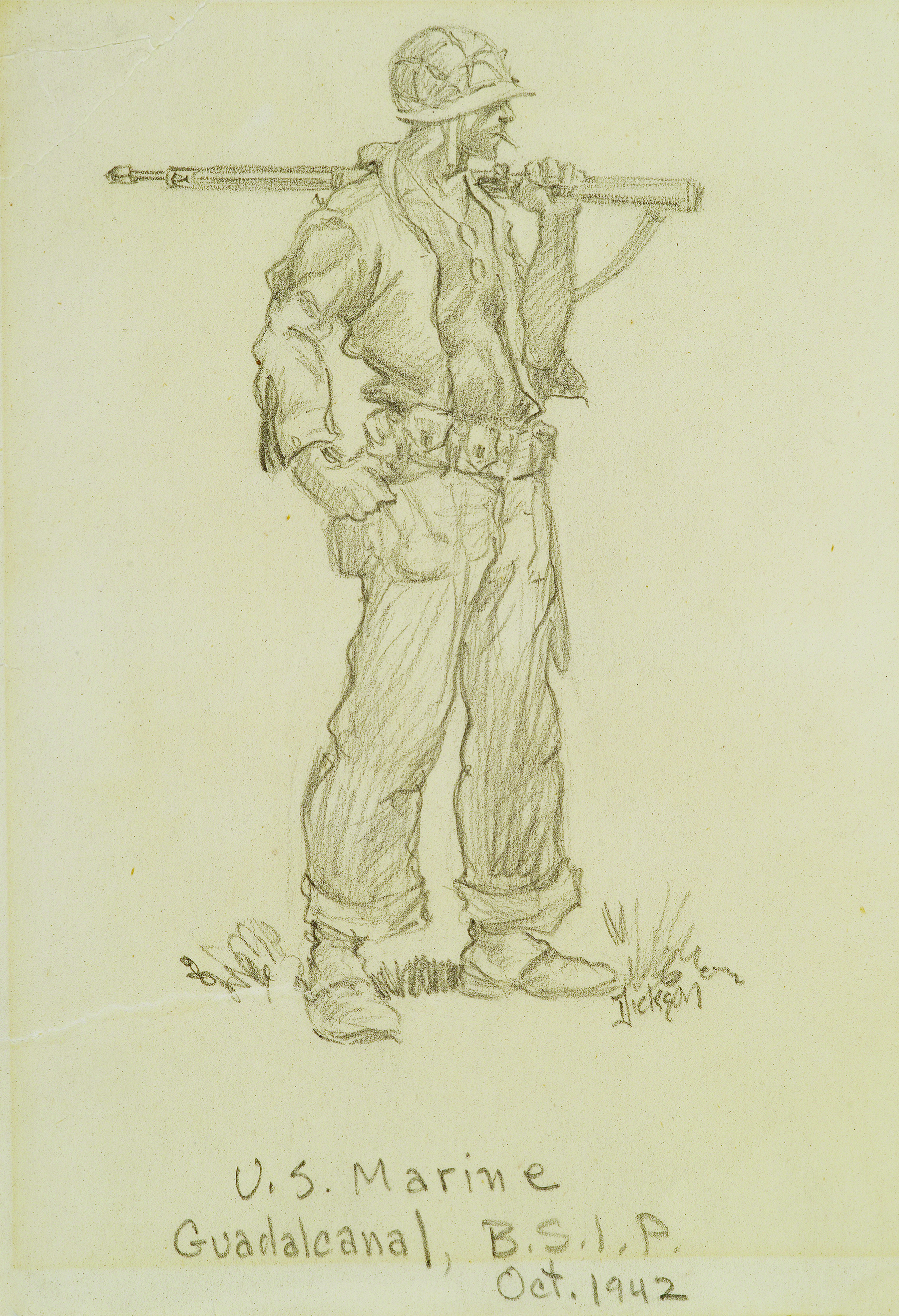
A Dickson sketch portraying Marines on Guadalcanal.
National Museum of the Marine Corps.
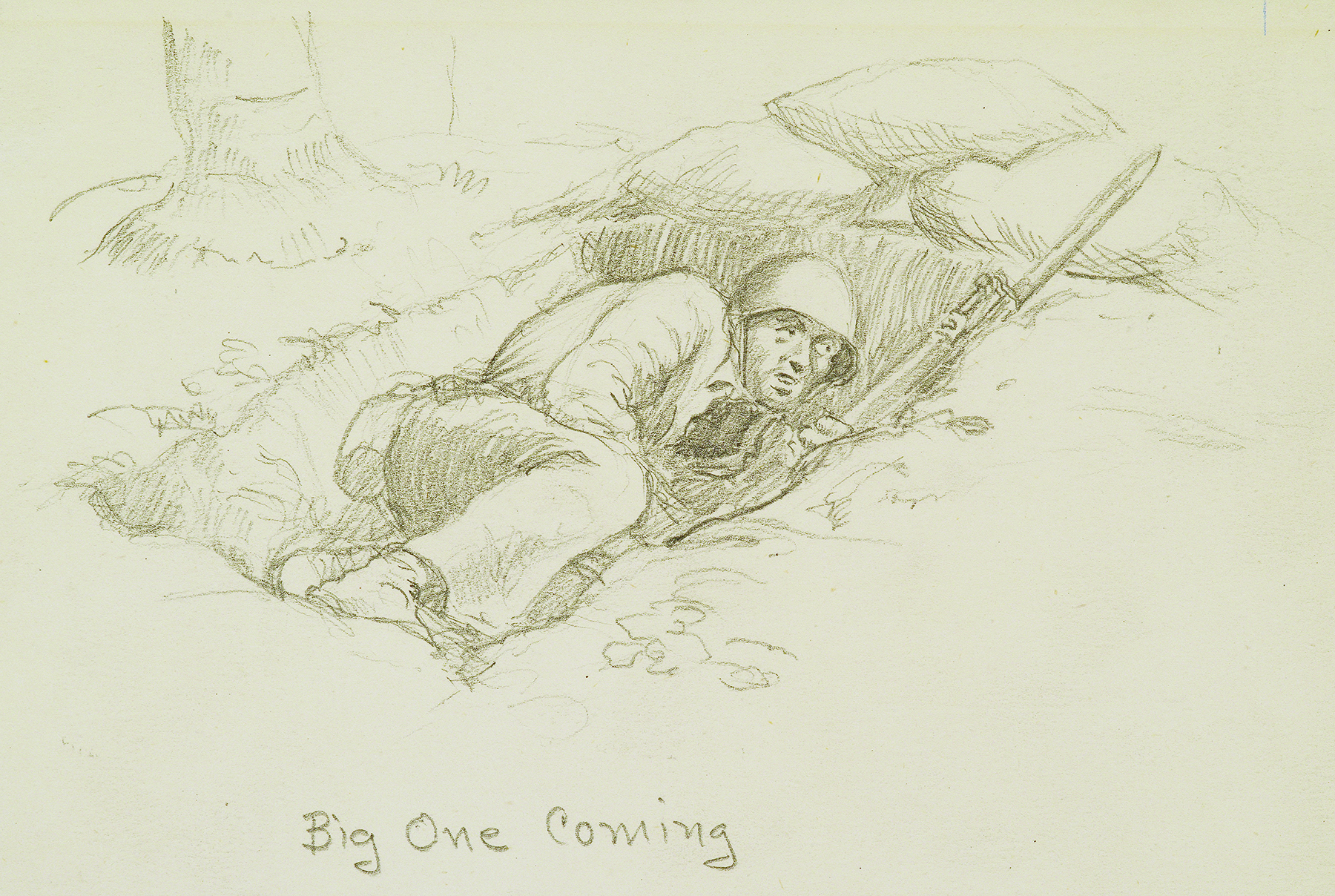
A Marine takes cover during one of many nightly shellings of Guadalcanal by Japanese warships offshore.
National Museum of the Marine Corps.
Some History of the George Medal
During the campaign on Guadalcanal, Marine Corps lieutenant colonel Merrill B. Twining served as the 1st Marine Division’s assistant operations officer and later assistant chief of staff. Along with deserving credit for helping to plan the Marines’ eventual victory, he can also lay partial claim to inventing the infamous George Medal.
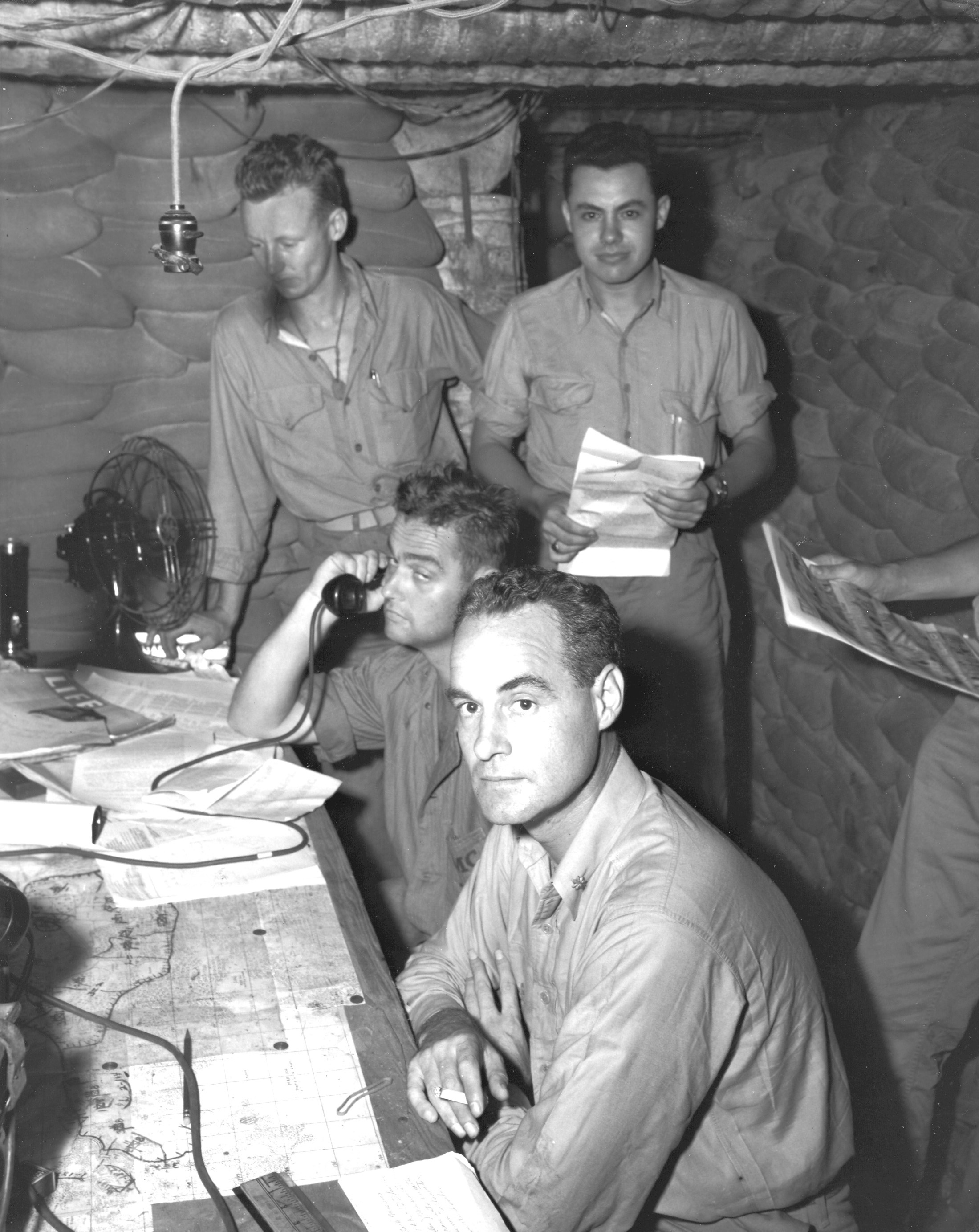
Future Marine Corps general Merrill B. Twining (forefront) plans Marine operations during the Guadalcanal campaign.
Official U.S. Marine Corps photo.
In postwar interviews, Twining recalled that, “One evening on Guadalcanal . . . a group of us were discussing the situation—the enemy, the lack of support, chow, ammunition, and everything else, when I suggested that we design a medal to commemorate the campaign.” The satirical idea was an immediate hit. Twining continued, “We all got a good laugh out of that.”[6] As a distraction from the horrors of war, the Marine officers continued to expand upon their idea and add more humorous touches. It was decided that the medal should recognize their ignoble distinction as the “Let George Do It” division. To add a touch of class to the title, they employed a British military officer and coastwatcher on Guadalcanal, Captain Martin Clemens, to translate their title in Latin. As a result, “Let George do it” became the more sophisticated Faciat Georgius.[7] The specific heraldry of the medal would add additional humor. A large Saguaro cactus represented the “cactus” codename for the island of Guadalcanal. The focal point of the award depicted a large U.S. Navy admiral’s uniform sleeve and hand dropping a proverbial “hot potato” into a small scrambling Marine’s outstretched hand. The reverse of the medal was less subtle and more scatological in nature. Original suggestions for a depiction of a Japanese soldier relieving himself, strategically placed near a large running office fan, were eventually overruled in favor of a more conservative cow exercising the same bodily action. A formal inscription followed below:
IN FOND REMEMBRANCE OF THE HAPPY DAYS SPENT
FROM AUG 7th 1942 TO JAN 5th 1943
U.S.M.C.
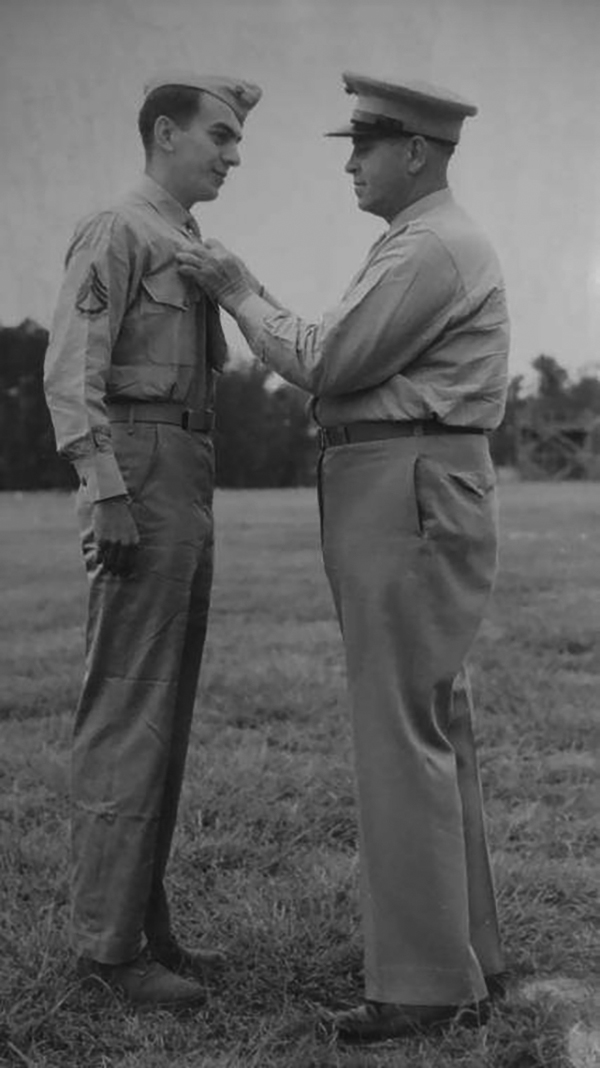
Vernon Stimpel receives a decoration following the Battle of Guadalcanal.
National Museum of the Marine Corps.
In lieu of a colorful, decorative fabric ribbon, it was further decided that the ribbon would be made from a well-worn combat uniform in recognition of the Marines’ down-trodden status. To formally design the conceptual medal, the Marine officers enlisted the help of Donald Dickson, a talented artist who later became the editor of Leatherneck magazine.[8]
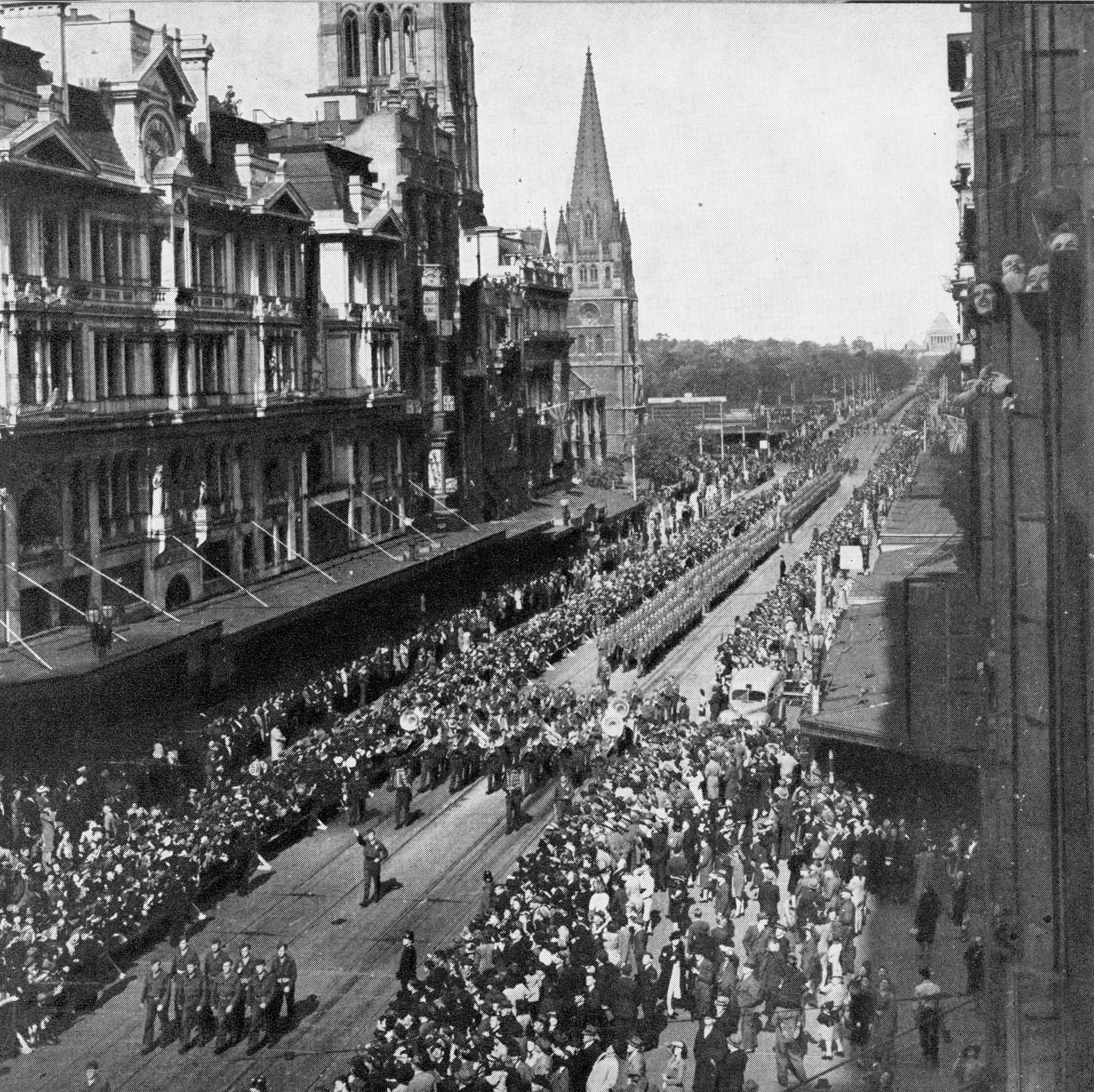
The 1st Marine Division marches through the city of Melbourne, Australia, following their withdrawal from Guadalcanal.
Official U.S. Marine Corps photo.
When the 1st Marine Division arrived in Melbourne, Australia, in January 1943, the Marines finally had the time and ability to make their humorous medal a reality. According to at least one source, they were thwarted on the first try. The division’s press officer, Lieutenant Herbet C. Merillat, was turned away by a local manufacturer who recognized that the award was not officially approved and feared repercussions from military authorities if he allowed his staff to create it.[9] Undaunted, the division staff looked elsewhere. They sent the division’s intelligence section clerk, Corporal Vernon C. Stimpel, with their conceptual artwork to a small engraving shop near Little Collins Street in Melbourne. There, the engravers created a crude sand cast mold. Stimpel donated his own herringbone twill utility uniform to be cut apart and serve as the source for the first run of the medals’ ribbons. In a previously unpublished letter to the 1st Marine Division Association written in 1974, Stimpel clarified these long-forgotten details on the true origins of the medals’ creation. In this letter he also noted that the initial order called for 100 awards to be cast. These original medals had a traditional medal pin and clasp attached to the herringbone twill fabric ribbon. Additionally, the distinctive stripes of a Navy admiral were clearly seen on the sleeve of the arm on the medal’s front. Stimpel owned medal #45 of the initial 100 medals made. His letter further clarified that as the medal’s popularity and demand grew, a second run of 400 awards were made by the same engraving shop. Over time, each subsequent casting began to lose the original detail of the first batch, with small details such as the admiral’s sleeve markings becoming less prominent. This later contract also forfeited the traditional metal pin and clasp; they were presented with a comically oversized laundry bag safety pin instead. The division’s lithographic section created a formal numbered certificate for each Marine entitled to the “award.”[10] For many years, veterans and collectors have repeated the unverified story that the original casting mold broke at an unknown time. This makes determining exactly how many original Australian medals were produced forever unknown. However, another mold for manufacturing new George Medals still exists. This was donated to the U.S. Marine Corps History and Museums Division circa 1978. The artifact came from the son of Brigadier General James J. Keating, who had served as the commanding officer of 3d Battalion, 11th Marines, on Guadalcanal. According to the family, Keating had commissioned its manufacture after the war ended to create more George Medals for veterans who had previously been unable to obtain one.[11] These were then presented at various veterans’ reunions, thereby confirming at least a third type of medals created.
Endnotes
[1] “The Soochow Creek Medal,” Walla-Walla, 15 April 1933.
[2] Henry I. Shaw Jr., First Offensive: The Marine Campaign for Guadalcanal, Marines in World War II Commemorative Series (Washington, DC: Marine Corps Historical Center, 1992), 1.
[3] Shaw, First Offensive, 4.
[4] Shaw, First Offensive, 14.
[5] Shaw, First Offensive, 51–52.
[6] P. L. Thompson, “Let George Do It,” Leatherneck 65, no. 8 (August 1982): 24.
[7] Thompson, “Let George Do It,” 25.
[8] Thompson, “Let George Do It,” 25.
[9] Richard D. Camp Jr., “The ‘George Medal’ and Guadalcanal,” Military Heritage 6, no. 5 (April 2005).
[10] Letter from Vernon C. Stimpel to 1st Marine Division Association, 13 March 1974.
[11] Kenneth L. Smith-Christmas, curatorial memorandum for object 1981.63.1.